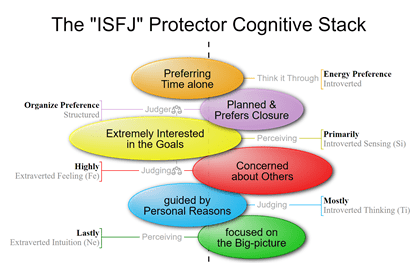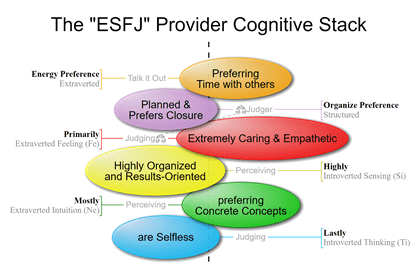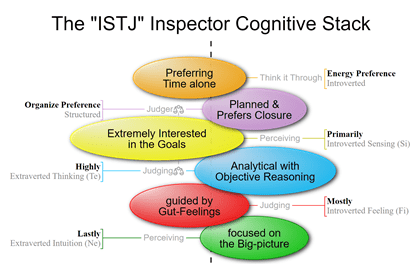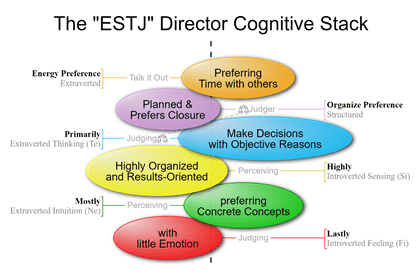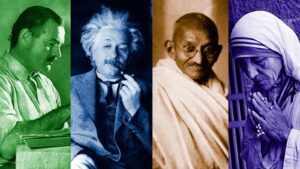
What is the Keirsey “Guardian” Personality Temperament?
Guardians have a Concrete Communication Style and a Cooperative Action Style. They talk primarily about their duties and responsibilities and what they can monitor and take good care of. They’re careful to obey the laws, follow the rules, and respect the rights of others.
- Guardians pride themselves on being dependable, helpful, and hard-working.
- Guardians make loyal mates, responsible parents, and stabilizing leaders.
- Guardians are dutiful, cautious, humble, and focused on credentials and traditions.
- Guardians are concerned citizens who trust authority, join groups, seek security, prize gratitude, and dream of meeting justice.
- Guardians seek security and a desire for belonging.
- Guardians are best at logistics, are great organizers, checkers, and facilitators, and are very supportive of others.
- Generally, they are more left-brain dominant, conservative black-and-white thinkers who prefer things remain safe, secure, and the same.
Keirsy Guardian Personality Type cross-reference
- Temperament Type – Melancholy
- Animal Type – Beaver
- DISC Type – Compliant
- Socio-Communicative Type – Analytical
- True Colors – Gold
- Color Code – White
- Personality Compass – East
- Occupational Type – Realistic
- Learning Type – Pragmatist
- Leadership Type – Avoider
Keirsy Guardian Correlated MBTI Sensing/Judging (SJ) Types
Keirsey classified the Guardian as Concrete/Sensing with Judging (xSxJ) MBTI Personality Types. These include the Types with Introverted Sensing and Extraverted Thinking or Feeling (a Judging Function) as the first Dominant or second Auxiliary Functions in either order.
- The Protector (ISFJ) is a conservator who excels in supporting and securing.
- The Provider (ESFJ) is a conservator who excels in supporting and supplying.
- The Inspector (ISTJ) is an administrator who excels in regulating and certifying.
- The Supervisor (ESTJ) is an administrator who excels in regulating and enforcing.
ISFJ and ESFJ Types are Guardians with Introverted Sensing and Extraverted Feelings as the first Dominant and second Auxiliary Functions in either order.
ISTJ and ESTJ MBTI Types are Guardians with Introverted Sensing and Extraverted Thinking as the first Dominant and second Auxiliary Functions in either order.
Keirsy Guardian Enneagram Types
- Type 1 – The Reformer (All Judging)
- Type 2 – The Helper (ESFJ, ISFJ)
- Type 6 – The Loyalist (All Sensing)
- Type 8 – The Challenger (ESTJ)
What are the Keirsy Personality Temerpaments?

David Keirsey, born in 1921, was an American psychologist specializing in conflict management and family counseling. He began researching human behavior and Personality in the 1940s.
Keirsey blended the Myers-Briggs Personality Types with Ernst Kretschmer’s model of the Four Temperaments, developing the Keirsey Temperament Sorter, which was made famous by his book “Please Understand Me.”
Instead of using the term Personality, Keirsey used Temperament. He viewed it as a configuration of observable Personality Traits, communication habits, patterns of action, characteristic attitudes, values, and talents. To Keirsy, Temperament encompasses personal needs, individual contributions, workplace contributions, and societal roles.
Keirsey organized his Four Temperaments as a matrix and named them as suggested by Plato: Artisan (Iconic), Guardian (Pistic), Idealist (Noetic), and Rational (Dianoetic).
The matrix is divided in half vertically by Communication Styles: Concrete versus Abstract. The matrix is divided horizontally into two action styles: Cooperative and Utilitarian.
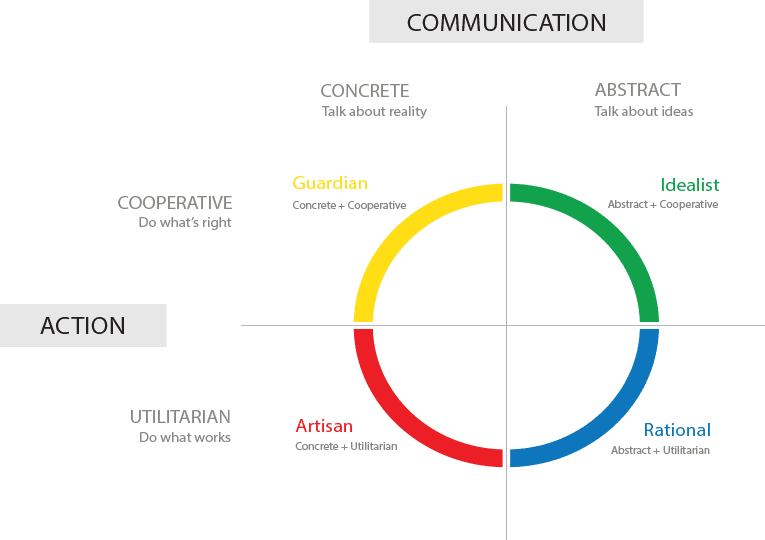
Learn more about the Keirsey Temperaments.
Concrete versus Abstract Communication Style
Some people are focused and like to talk primarily about the external, concrete world of everyday reality: facts and figures, their work, home, family, the news, sports, and weather—all the who, what, when, where, and how things in their lives.
Other people primarily like to talk about the internal, abstract world of ideas: theories and conjectures, dreams and philosophies, beliefs and fantasies — all the whys, ifs, and what might be in life.
For the most part, Concrete people talk about reality, while Abstract people talk about ideas.
According to Keirsey, everyone can engage in both observation and introspection. People are observant when they touch objects or otherwise perceive the world through their five senses. When people reflect and focus on their internal world, they are introspective.
However, individuals cannot simultaneously engage in observation and introspection. The extent to which people are more observant or reflective affects their behavior.
Observant people focus on practical matters such as food, shelter, and their immediate relationships. Carl Jung used “Sensation” to describe people who prefer Concrete perception.
Reflective people are more ‘head in the clouds’ and abstract in their views. They focus on global or theoretical issues such as equality or engineering. Carl Jung used the word Intuition when describing people who prefer Abstract perception.
Keirsey’s two Communication Styles, Abstract versus Concrete, are similar to the Myers-Briggs “Perceiving” Cognitive Functions, Intuition (Abstract) and Sensing (Concrete).
Cooperative versus Utilitarian Action Style
Some people act practically and pragmatically; that is, they do what gets results, what achieves their objectives as effectively or efficiently as possible. They only check afterward to see if they observe the rules or go through the proper channels. People with this behavior have a Utilitarian Action Style.
On the other hand, some people act primarily cooperatively and socially acceptable; they try to do the right thing in keeping with agreed-upon social rules, conventions, and codes of conduct. Only later do they concern themselves with the effectiveness of their actions. People with this behavior have a Cooperative Action Style.
Utilitarian people mostly do what works, while Cooperative people do what’s right.
Cooperative-type people pay more attention to other people’s opinions and are more concerned with doing the right thing. Meanwhile, Utilitarian-type people pay more attention to their thoughts or feelings and are more concerned with doing what works.
The two Cooperative Temperaments are the Idealists (Cooperative and Abstract) and Guardians (Cooperative and Concrete).
The two Utilitarian Temperaments are the Rational (Pragmatic and Abstract) and the Artisan (Pragmatic and Concrete).
Neither the MBTI nor Jung has a corresponding or comparable dichotomy to the Keirsey Action Style classification. Action Style significantly differs between Keirsey’s Temperaments and Myers and Jung’s work in Cognitive Personality Styles.
Keirsy Guardian Personality Temperament
Guardians are the cornerstone of society, for they are the Temperament given to serving and preserving our most important social institutions.
Guardians have natural talent in managing goods and services—from supervision to maintenance and supply—and use all their skills to keep things running smoothly in their families, communities, schools, churches, hospitals, and businesses.
Guardians can have fun with their friends but are serious about their duties and responsibilities. They take pride in being dependable and trustworthy.
Guardians also believe in law and order and sometimes worry that respect for authority, even a fundamental sense of right and wrong, is lost. Perhaps this is why Guardians honor customs and traditions so strongly — they are familiar patterns that help stabilize our modern, fast-paced world.
Guardians are practical and down-to-earth, believing in following the rules and cooperating with others.
They are uncomfortable winging it or blazing new trails; working steadily within the system is the Guardian way, for in the long run, loyalty, discipline, and teamwork get the job done right.
Guardians are meticulous about schedules and have a sharp eye for proper procedures.
They are cautious about change, even though they know it can be healthy for an institution. Better to go slowly, they say, and look before you leap.
Guardians make up as much as 40 to 45 percent of the population, and this is a good thing because they usually end up doing all the indispensable but thankless jobs the rest of us take for granted.
Famous Guardians
Presidents George Washington, Harry S. Truman, William Howard Taft, and Mother Teresa are examples of Guardians.

